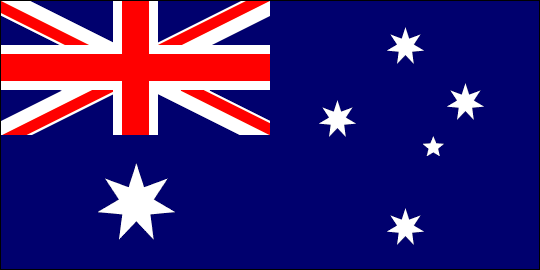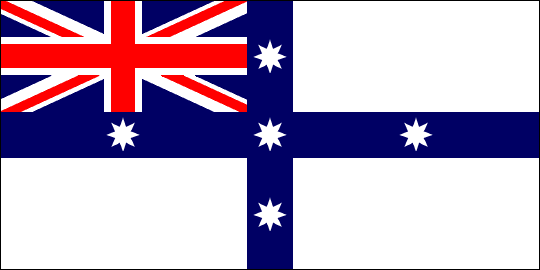CURRENT AUSTRALIAN FLAG

Flag Adopted: 20 February 1903
Modified: 22 May 1909
Proclaimed by Legislation: 14 April 1954
Flag Proportion: 1:2
Use: State and Civil Flag, Naval Jack
Following federation of the six Australian colonies in 1901, a nationwide competition was held to find a new Australian flag. Over thirty thousand entries were submitted, some were practical, some complex and extravagant. In the end, five people from around the country submitted a similar design that was selected to be the Australian National flag. It was announced as the winner on 3 September 1901. It was one of two designs submitted to the British Admiralty who made the final choice, the other design being the previously used "Federation Flag". The Blue Ensign selected is essentially the flag we have today, although minor modifications have been made to the number of points on the stars. The Union Flag of Great Britain occupies the canton. Below this is the seven-pointed federation star (changed from six points in 1909). In the fly are the five stars that make up the Southern Cross.
The Australian flag is essentially a British Blue Ensign charged with the Commonwealth Star and Southern Cross. Prior to federation, the six colonies (and indeed all British colonies around the world) were required to fly the British Blue Ensign with their respective colonial badge in the fly. Therefore, although the competition did not specify that the flag had to be a variant of the Blue Ensign, or indeed feature the Union Jack at all, it was natural that Australians would create designs that were also based on the Blue Ensign. Such designs were also favoured by the fact that the chosen design had to be approved by the Admiralty in Britain. Australia at this point was still considered very much a part of the British Empire. The British flag was still widely flown, and with precedence over the flags of the colonies. Although the new flag was gazetted by the government in 1903, it was not until 1954 that legislation was passed proclaiming the flag.
FEDERATION FLAG

Flag Adopted: circa 1823
Modified: Throughout the 19th century.
Flag Proportion: 1:2 (not official)
Use: De facto national flag. Widely used as a flag of the Australian colonies
before 1901, but never officially adopted.
The Australian Blue Ensign was not the first flag to be recognised as the Australian National Flag. At the federation celebrations in 1901, prior to the national competition, a strikingly different design was flown alongside the Union Jack as the flag of the new Commonwealth. This flag featured a blue cross on a white background with the Union Jack in the canton. The cross was charged with five white stars, a representation of the Southern Cross. At one point this so called "Federation Flag" may even have been officially adopted as the national flag of Australia.
The earliest record of the flag comes from 1832 when it was recorded as the New South Wales Ensign. At this point it would have have flown over all of eastern Australia, as the colonies of South Australia, Victoria and Queensland had yet to be formed. A later record states that the flag was adopted some nine years earlier, but without the centre star and with the cross red instead of blue. Such a design is clearly an adaptation of the British White Ensign, which features the red cross of St George on a white background with the Union Jack in the canton.
The flag was widely flown, even though it never enjoyed official status. The flag had many variations; the shade of blue on the cross, the number of points of the stars (generally five or eight), and even the number of stars themselves. It is possible that its usage diminished when the colonies officially adopted British Blue Ensigns as flags after 1865. In the 1890's however, as the push for federation of the colonies gained momentum, the flag saw a resurgence in popularity. Supporters of federation flew the flag as a symbol of nationhood, and the flag featured prominently in pro-federation literature of the time.
In 1902, after the national flag competition, the Prime Minister, Edmund Barton, sent two designs to the British Admiralty for approval, the winning Blue Ensign and the Federation Flag (with seven-pointed stars). The Admiralty later that year confirmed the Blue Ensign as the Australian National Flag. It can be seen that the final choice rested with Britain. Despite the popularity of the Federation Flag, Britain chose the Blue Ensign instead. No reasons for the decision are known to have been given, but there are theories. As all other British colonies and dominions flew variations of British ensigns, such a radical flag might have been seen as claiming special status or even championing separation from the British Empire. There also exists in the Royal Navy records an 1883 request for the practice of flying the New South Wales Ensign to cease, as it resembled too closely the British White Ensign flown by the Navy.
Despite never being officially adopted, the practice of flying the Federation Flag continued, even after 1901. The Blue Ensign was the flag of the Australian Government and as such was not for personal use. Instead, the Australian people continued to fly the Federation Flag. Gradually however, as the Blue and Red Ensigns became more widely used it disappeared, becoming an almost forgotten relic of Australia's colonial past.
Reference: Tony Burton; "Australia's Forgotten Flag"; Crux Australis, Volume 8/4 No. 36; October-December 1992.
This site and contents - © Dylan Crawfoot 1999